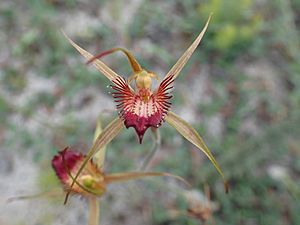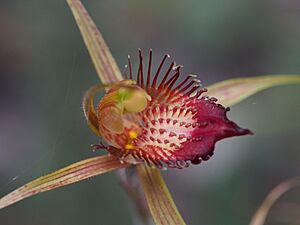Tuart spider orchid facts for kids
Quick facts for kids Tuart spider orchid |
|
|---|---|
 |
|
| Caladenia georgei growing west of Preston Beach | |
| Scientific classification | |
| Genus: |
Caladenia
|
| Species: |
georgei
|
| Synonyms | |
|
|
The Tuart spider orchid (Caladenia georgei) is a special type of orchid. It grows only in the south-west part of Western Australia. This plant has one fuzzy leaf. Its flowers are usually whitish or yellowish-green with a touch of red. They also have a white lip, called a labellum, with a red tip.
Contents
What Does the Tuart Spider Orchid Look Like?
The Tuart spider orchid is a plant that grows from the ground. It is a perennial plant, which means it lives for more than two years. It is also deciduous, so its leaves fall off at certain times. This plant has an underground tuber, which is like a storage part for food.
It grows a single, upright, hairy leaf. This leaf can be about 120 to 220 millimeters (5 to 9 inches) long. It is also about 5 to 12 millimeters (0.2 to 0.5 inches) wide.
The Flowers of the Orchid
The orchid grows up to three flowers on a tall stalk. This stalk can be 250 to 500 millimeters (10 to 20 inches) high. Each flower is about 60 to 100 millimeters (2 to 4 inches) long. They are also 50 to 80 millimeters (2 to 3 inches) wide.
The flowers are whitish or yellowish-green. They often have a reddish color mixed in. The side parts, called lateral sepals, have narrow, club-like tips. These tips are glandular, meaning they can produce substances.
The lateral sepals and petals spread out wide. They also curve downwards. The top sepal, called the dorsal sepal, stands straight up. It is about 50 to 75 millimeters (2 to 3 inches) long. Its base is about 3 millimeters (0.1 inches) wide.
The lateral sepals are 45 to 85 millimeters (1.8 to 3.3 inches) long. They are 4 to 6 millimeters (0.16 to 0.24 inches) wide. The petals are 45 to 50 millimeters (1.8 to 2.0 inches) long. They are 2 to 4 millimeters (0.08 to 0.16 inches) wide.
The Labellum (Lip)
The labellum is the special lip-like part of the flower. It is 12 to 25 millimeters (0.5 to 1.0 inches) long. It is also 10 to 18 millimeters (0.4 to 0.7 inches) wide. The labellum is white with a red tip.
The sides of the labellum have spreading teeth. These teeth are tipped with red. They can be up to 12 millimeters (0.5 inches) long. The very tip of the labellum curves downwards.
There are four rows of red calli along the center of the labellum. Calli are small, raised bumps. These calli can be up to 2 millimeters (0.08 inches) long. The Tuart spider orchid usually blooms in September and October.
How Did It Get Its Name?
The Tuart spider orchid was first officially described in 2001. Two scientists, Stephen Hopper and Andrew Phillip Brown, described it. They found a specimen near Bunbury. Their description was published in a science journal called Nuytsia.
The second part of its scientific name, georgei, honors a person. It was named after a botanist named Alex George. A specific epithet is the second part of a plant's scientific name.
Where Does It Grow?
The Tuart spider orchid grows in Western Australia. You can find it between Yanchep and Busselton. It lives in areas like the Jarrah Forest and Swan Coastal Plain. These are special biogeographic regions known for their unique plants.
It prefers to grow in deep sandy soil. You can often find it in woodland areas. It especially likes tuart woodland.
Is It Safe?
The Government of Western Australia's Department of Parks and Wildlife checks on plants. They have classified Caladenia georgei as "not threatened." This means it is not currently in danger of disappearing.


